There’s never been an attraction anywhere on Earth quite like Star Wars: Rise of the Resistance – nothing as massively scaled; nothing as committed to immersion; nothing as filled with inexplicable, impossible, and ingenious Imagineering moments. More than an E-Ticket, this next-generation experience is one-of-a-kind… and yet, it’s made possible entirely by the Imagineering landmarks that have come before.
Today, we’ll set off into Star Wars: Rise of the Resistance to explore nine of this ride’s most surprising moments and inexplicable surprises. So be warned: if you haven’t experienced this 21st century masterpiece – or if you don’t want its jaw-dropping effects spoiled by learning their inner workings – maybe instead make your way to another in-depth feature.
For those who are ready to set off from Batuu and take on the might of the First Order, hold on tight. To uncover the Secrets of the Resistance, we’ll walk through the Rise experience from beginning to end, describe how its greatest tricks work, and explore the Imagineering “ingredients” – the prototypes and precedents – that add up to make this once-in-a-lifetime ride possible.
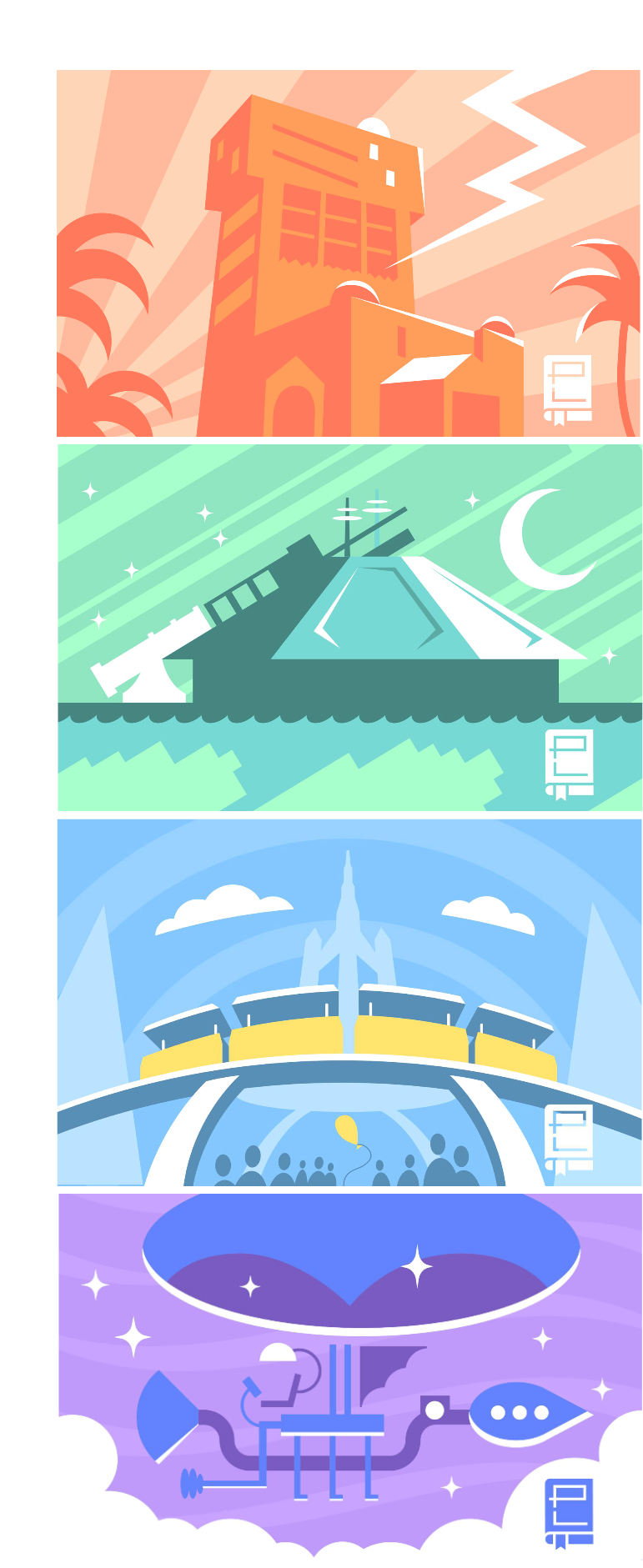
This in-depth article is just one entry in Park Lore’s one-of-a-kind Special Features collection, where we explore the threads that connect between rides, parks, and pop culture! From Imagineering’s secret Society of Explorers and Adventurers, to the history of Chuck E. Cheese; from Disney and Universal’s AVENGERS: “Custody War” to the two-part tale of animation’s rebirth in the generation-defining ’90s Disney Renaissance!
Special Features are typically available exclusively for those who support this evolving theme park history project with a monthly Membership. It’s been unlocked for a limited time, but if you enjoy what you read, consider becoming a Park Lore Member for as little as $2 / month!
1. The Resistance Encampment
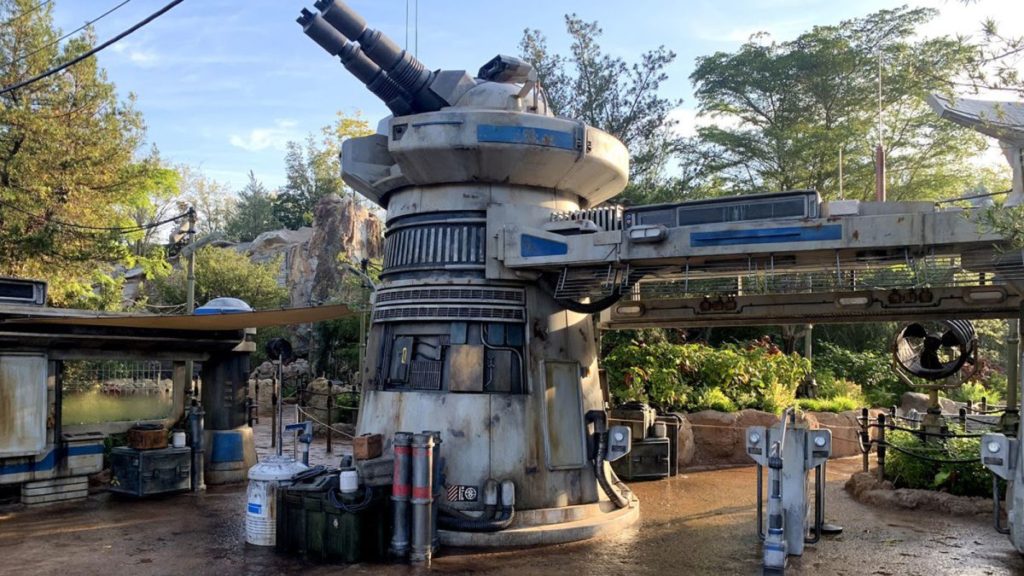
Before Rise of the Resistance opened, tens of thousands of guests walked right past it and never noticed. That’s because Rise is hidden away in the wilderness of Batuu, far outside the bustling marketplaces of Black Spire Outpost. The only landmark at its entry is a piece of old, rusted artillery. Beyond that, a winding queue leads through a waterfall-fed oasis and into ancient caverns carved through the planet’s rocky spires. Those unassuming natural caves soon give way to chiseled-out bunkers strung up with makeshift wiring, tunnels held up by hydraulic presses, and scattered collections of Resistance equipment, ready to be picked up and moved in a hurry.
How It Works
“Immersive queues” have been a signature of Disney’s E-Ticket attractions since the “Ride the Movies” era that began with the Lost Legend: STAR TOURS. The idea of using a queue as part of the experience – an opportunity to settle into the “world” and get into the “headspace” of an immersive ride – was an important innovation in the design of queues.

At Rise of the Resistance, the winding queue passing through the overgrown remains of a Batuuan encampment are doubly important. They not only give guests a glimpse at the “history” of the planet, but set up the makeshift solutions that the Resistance has invented, wiring up old caverns and bunkers as a way of skirting the First Order’s notice. The queue also establishes a very, very strong aesthetic for the Resistance – earthly, brown, organic, and nimble – which contrasts strongly with the cold, silver and blue, metallic authoritarianism of the First Order.
Imagineering Ingredients
We say that the queue here learns from two important Imagineering precedents:
- Indiana Jones Adventure at Disneyland has one of the world’s most beloved queues, which seems like an odd thing to say until you’ve walked through it. The quarter-mile trek to the ride’s hidden showbuilding is disguised as a descent through the ruins of the Temple of the Forbidden Eye, with ancient tunnels, rotundas, caverns, and cathedrals to the lost god Mara along its course. It’s clear that the artistry behind the queue is as intense as that of the ride, and so it is on Rise, where rockwork rivaling Cars Land surrounded guests… all while they wait!
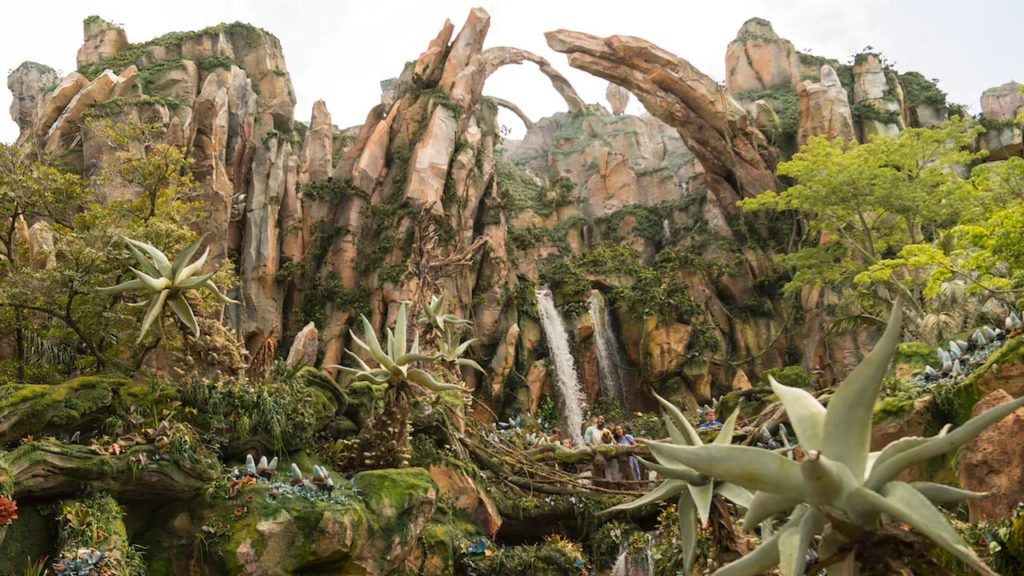
- Avatar Flight of Passage is perhaps the best Standby queue in Orlando. Aesthetically, the line for Flight of Passage sees guests physically rise through the mountains of Pandora, passing through caverns and reclaimed laboratories and overgrown ruins just like Rise. Narratively, the hour-plus wait is also important, lending a sense of importance to the ride to come. It’s the same with Rise of the Resistance, where the physical wait may not be fun per se, but it somehow feels like a requirement to understand how important the rite of passage to follow really is.
2. The Intersystem Transport
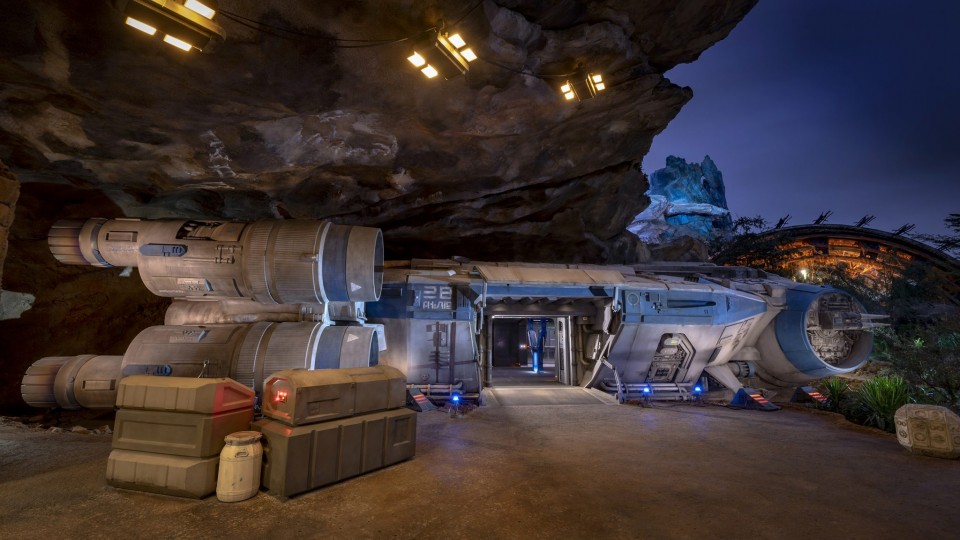
After a briefing from Rey and BB-8, guests are given their mission: with the First Order having descended on Black Spire Outpost, we – the recruits – have no choice but to evacuate the encampment at Batuu and instead rendezvous with General Organa at a new Resistance base on Pacara.
With an escort by Poe Dameron ready to deliver us to the Mid-Rim planet, recruits are released outdoors, where an Intersystem Transport Shuttle piloted by Lieutenant Bek and Nien Nunb awaits on the rocky cliffs of Batuu. The ship’s starboard doors open as its thrusters begin to warm up, blazing deep blue against the planet’s Spires.
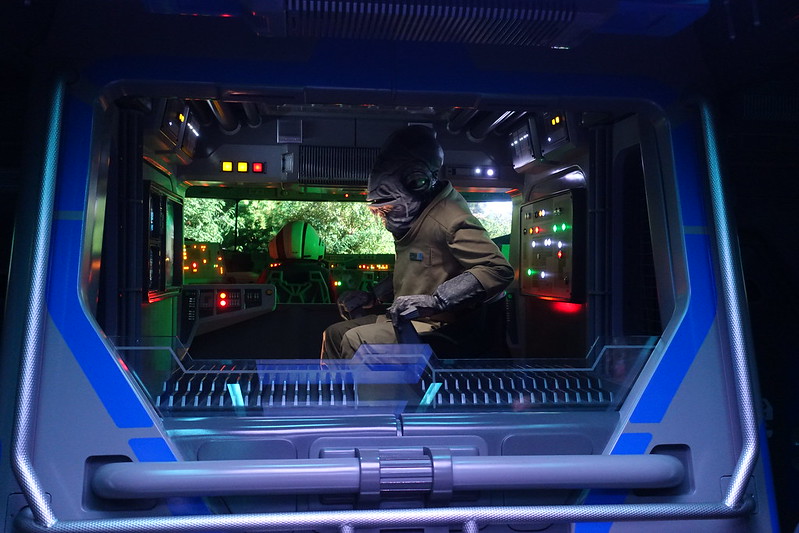
Once standing on board with Nien Nunb and Bek in the flesh, the Transport lurches forward, rising and swaying as it lifts off from Batuu, breaking through the clouds and out of the planet’s atmosphere. However, the First Order launches a surprise attack, grabbing the Transport in a tractor beam. As we’re pulled through the humming blue magnetic shield airlock, Dameron jumps to lightspeed, promising to return with reinforcements. As the Bek instructs us to keep the location of the Pacara base secret, the starboard doors open again, but this time, officers of the First Order step aboard, instructing guests to exit into the hangar and prepare for interrogation.
How It Works
The same starboard door opening both times leaves many riders genuinely shocked by the improbable – yet undeniable – proposition that the Transport did move… That’s because it did! If it weren’t for the whole rest of Rise of the Resistance, the Transport would easily be one of the most clever and sensational tricks in any Disney Park.

In reality, the Transport you see parked on Batuu never moves even an inch. It’s a facade that conceals a circular showbuilding with three Transport interior spaces arranged on a very large turntable. Once loaded, a “takeoff” sequence rotates the turntable to the second of three positions, where the “show” takes place. Then, it rotates to the third position, aligning behind a second Transport facade in the Star Destroyer hangar where guests are released. The physical rotation of the turntable ingeniously adds a “thrust” to takeoff and a physical “halt” to the ship’s coming to rest in the Star Destroyer, leaving this easily among the most genuinely shocking “how’d they do that?” moments in the park, surpassed only by what’s to come.
Imagineering Ingredients
We can’t think of many other “ride to get to the ride” situations (though that sort of thing has been “faked” here and there, as we’ll discuss later). But there are a few important precedents here:
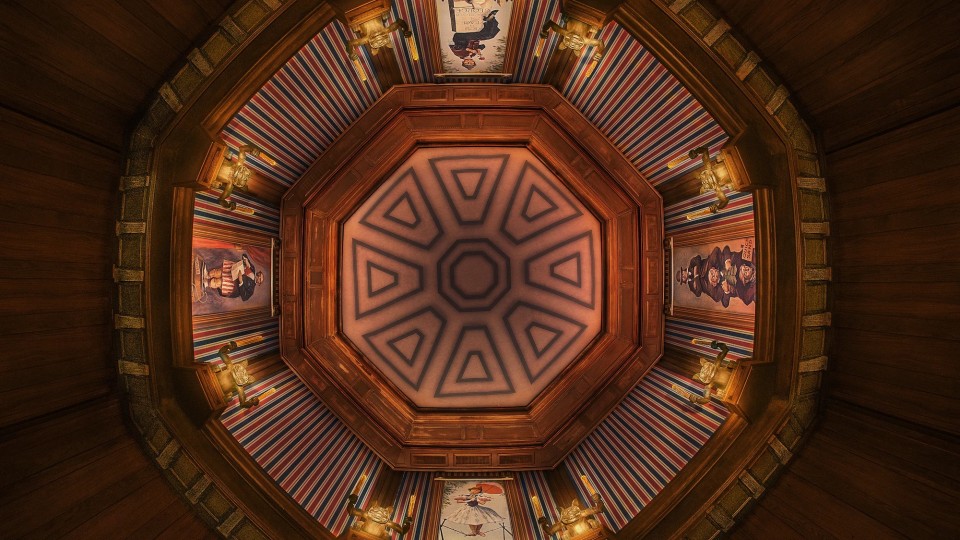
- The Haunted Mansion at Disneyland does indeed have a real, necessary “ride to get to the ride.” In California, the Stretching Room does the essential job of lowering guests to a basement level so that they can pass under the Disneyland Railroad. (The scene is so iconic, though, that it was retained for other versions of the Haunted Mansion without the functional elevator piece; instead of the floor lowering, the ceilings rise.)
- Carousel of Progress is an unlikely “ingredient” here since – like that 1964 classic – the Transport is essentially a giant turntable with three audiences in one of three positions: Batuu (load), the “show,” and the Star Destroyer (unload). Like Carousel of Progress, that makes the Transport surprisingly high capacity.
B-Mode
If an Audio-Animatronic on board the Transport is not operational, a wall can be raised to block views of the cockpit while Nien Nunb and Lieutenant Bek switch their appearance to the ship’s screens. If the turntable is down, there’s no B-Mode except a very depressing and inexplicable walk down a behind-the-scenes Cast Member hallway that connects Batuu to the Star Destroyer’s hangar. (Many fans contend that if the turntable is not operational, the entire ride should default to being closed, which sounds right in theory, but would anger a whole lot of very eager guests… a real dilemma to be sure.)
3. The Interrogation
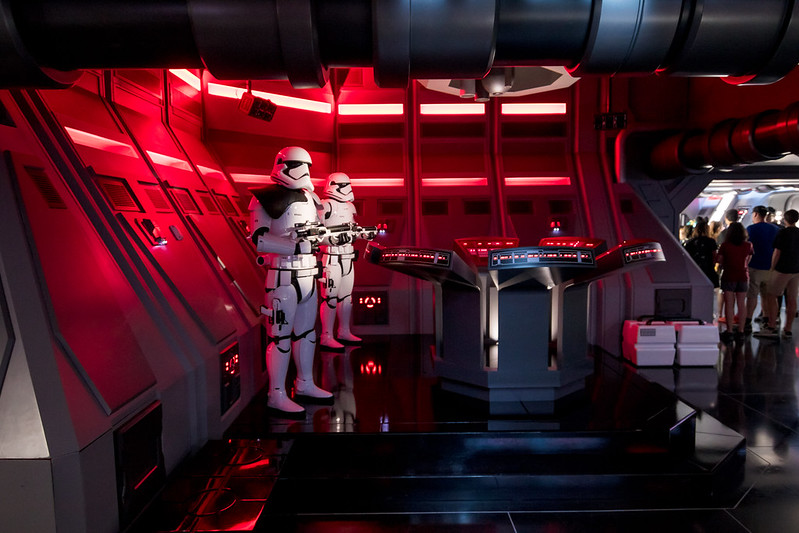
Once escorted out of the hangar, guests pass through labyrinthine corridors of the Star Destroyer, always under the watchful eye of Stormtroopers. Eventually, guests are sorted into smaller groups, led into a cell, and readied for interrogation.
General Hux and Kylo Ren appear on a catwalk overhead, insisting that they know we’re recruits of the Resistance and demanding we hand over the location of the secret base or have it taken from us. A goosebumps-inducing moment sees Kylo Ren use the Force on us… but before he can finish the job, he’s called away to the bridge, where he’ll be waiting for us…
How It Works

General Hux and Kylo Ren are seen “in the flesh” for the first time during the Interrogation. However, they’re not really “in the flesh.” Here, the two characters are brought to life by a special kind of projection called Musion projection that makes them appear to inhabit a 3D space. (Musion projection is a favor of Universal, where it’s used in each Harry Potter ride’s preshow, on Fast & Furious: Supercharged, and more.)
The trick is “sold” with a few added embellishments: red spotlights from behind the characters angled outward toward guests cast the characters’ shadows as they pace. In reality, the shadows are separate projections perfectly synched to the characters’ movements, subconsciously making the bad guys’ projected presence feel more real. Likewise, Kylo Ren’s control of the room’s lighting (and an associated Force moment, emphasized by subwoofers and a sudden, stark silence) make the projection far more physical than it would otherwise be.
Imagineering Ingredients
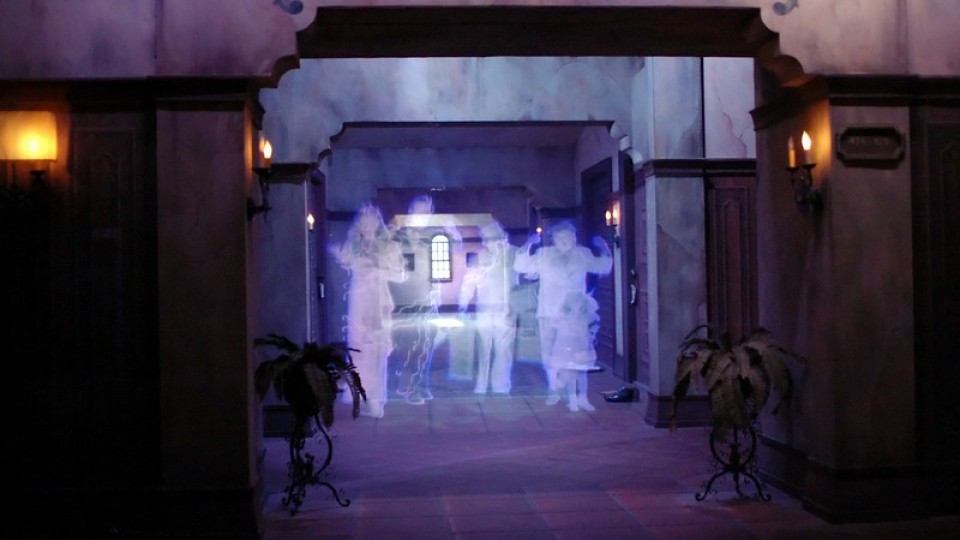
The Interrogation is both exceedingly simple and yet highly technological. Fittingly, we’d say its “ingredients” are one of each:
- The Haunted Mansion returns again, this time for its modern use of a very old trick. The “Pepper’s ghost” effect is a classic mid-19th century illusion that uses theatrical light and reflection to make objects appear out of thin air. The effect is popularly used in the Haunted Mansion’s ballroom scene, making translucent ghosts appear at the party (when in reality, guests are seeing reflections of Audio-Animatronics on a massive pane of glass. When lit, their reflection appears; when unlit, it disappears.)
- The Twilight Zone Tower of Terror was one of the first uses of Musion projection, which modernizes the Pepper’s ghost effect by instead reflecting a crystal clear projected image against a 45-degree-angled glass pane hidden between a physical foreground and background. The results (which you can also see as the pre-show in all of Universal’s Harry Potter rides and Fast & Furious: Supercharged) can make a projected image appear to inhabit a physical, 3-D space.
With our interrogation unfinished, we’re left in the cell to await our end… until hushed whispering and banging from a wall sees something extraordinary happen… Read on…


